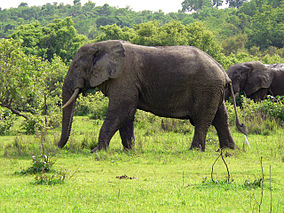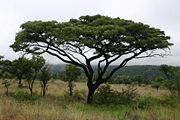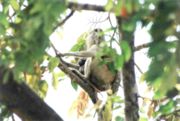
Mole National Park
About this schools Wikipedia selection
This wikipedia selection has been chosen by volunteers helping SOS Children from Wikipedia for this Wikipedia Selection for schools. To compare sponsorship charities this is the best sponsorship link.
| Mole National Park | |
|---|---|
 Elephants in Mole National Park. |
|
| Location | |
| Coordinates | 9°42′N 1°50′W Coordinates: 9°42′N 1°50′W |
| Area | 4840 km2 |
| Established | 1958 |
Mole National Park is Ghana's largest wildlife refuge. The park is located in northwest Ghana on grassland savanna and riparian ecosystems at an elevation of 150 m, with sharp escarpment forming the southern boundary of the park. The park's entrance is reached through the nearby community of Larabanga. The Lovi and Mole Rivers are ephemeral rivers flowing through the park, leaving behind only drinking holes during the long dry season. This area of Ghana receives over 1000 mm per year of rainfall. A long-term study has been done on Mole National Park to understand the impact of human hunters on the animals in the preserve.
History
The park's lands were set aside as a wildlife refuge in 1958. In 1971 the small human population of the area was relocated and the lands were designated a national park. The park has not seen major development as a tourist location since its original designation. The park as a protective area is underfunded and national and international concerns exist about poaching and sustainability in the park, but its protection of important resident antelope species has improved since its initial founding as a preserve.
The park is an important study area for scientists because of the removal of the human population from within the park allowing for some long-term studies, in particular, of relatively undisturbed sites compared to similar areas of densely populated equatorial West Africa. One study on the resident population of 800 elephants, for example, indicates that elephant damage to large trees varies with species. In Mole, elephants have a greater tendency to seriously injure economically important species such as Burkea africana, an important tropical hardwood, and Butyrospermum paradoxum, the source of shea butter, over the less important Terminalia spp.
Flora
Tree species of the park include Burkea africana, Isoberlinia doka, and Terminalia macroptera. The savanna grasses are somewhat low in diversity but known species include a spikesedge, Kyllinga echinata, an Aneilema, Aneilema setiferum var. pallidiciliatum, and two endemic members of the Asclepiadaceae subfamily, the vine Gongronema obscurum, and the edible geophyte, Raphionacme vignei.
Trees:
- Adansonia digitata
- Afzelia africana
- Anogeissus leiocarpus
- Afraegle paniculata
- Burkea africana
- Butyrospermum paradoxum
- Cassia sieberana
- Celastrus senegalensis
- Combretum ghasalense
- Detarium microcarpum
- Grewia lasiodiscus
- Grewia mollis
- Lannea acida
- Maytenus senegalensis
- Piliostigma thonningii
- Pterocarpus erinaceus
- Sterculia setigera
- Tamarindus indica
- Terminalia spp., including T. avicennioides
- Ximenia americana
Shrubs:
- Diospyros mespiliformis
- Feretia apodanthera
- Flueggea virosa
- Tinnsea spp.
- Urginea spp.
Herbaceous plants:
- Abutilon ramosum
- Aneilema umbrosum
- Atylosia scarabaeoides
- Blepharis maderaspatensis
- Desmodium velutinum
- Mariscus alternifolius
- Ruellia
- Sida urens
- Triumfetta pentandra
- Wissadula amplissima
Grasslands:
- Andropogon spp., including Andropogon gayanus var. squamulatus (a tall grass)
- Brachiaria spp.
- Loudetiopsis kerstingii
- Sporobolus pyramidalis (only in protected areas)
- Setaria barbata (only in protected areas)
Fauna
The park is home to over 93 mammal species, and the large mammals of the park include an elephant population, hippos, buffalo, and warthogs. The park is considered a primary African preserve for antelope species including kob, Defassa waterbuck, roan, hartebeest, oribi, the bushbuck, and two duikers, the red duiker and yellow-backed Duiker. Olive baboons, black-and-white colobus monkeys, the green vervet, and patas monkeys are the known species of monkeys resident in the park. Of the 33 known species of reptiles slender-snouted and dwarf crocodile are found in the park. Sightings of hyenas, lions and leopards are unusual, but these carnivores were once more common in the park. Among the 344 listed bird species are the martial eagle, the white-headed and palm-nut vultures, saddle-billed storks, herons, egrets, the Abyssinian roller, the violet turaco, various shrikes and the red-throated bee-eater.
Mole National Park, like other Ghanaian game preserves, is poorly funded for prevention of poaching. Poachers tend to live within 50 km of the boundaries of the park. This distance of 50 km is the reported greatest distance hunters were willing to travel with poached game. The remnant human population of the park was removed in 1961, leaving all game hunters outside the reserve, meaning that mammal populations on the edges of the park are impacted more by hunting than interior populations.


